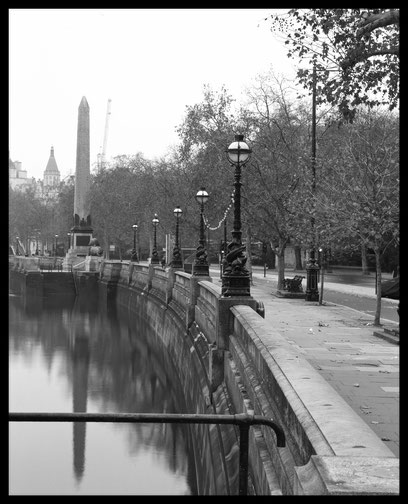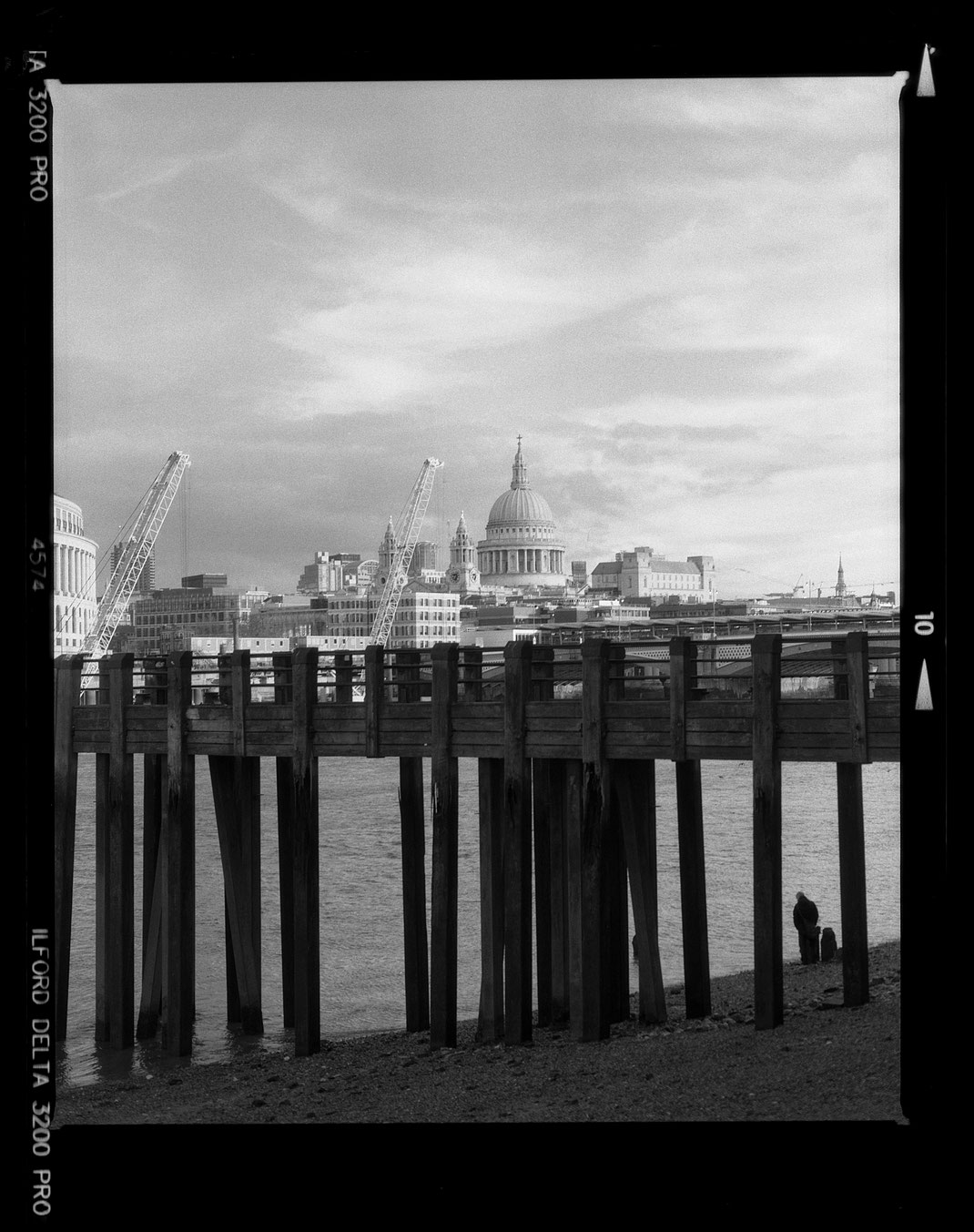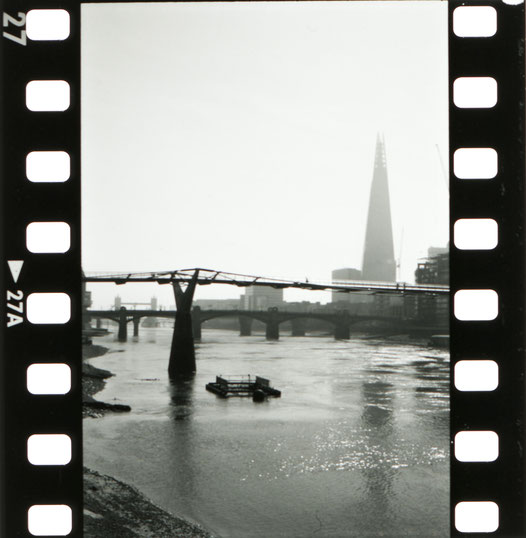
Thames, North Bank - Occasional Pieces / Abred. Title: Grow
You will either like or dislike a piece of work which is as it should be, there is a relationship between the viewer and the displayed work and that relationship intensifies with the viewers own self awareness and the strength of the artist and therefore the strength of the work A professional critic comes with knowledge and experience but also with his own preferences for Art in style and technique. The critic will look at a piece from an aesthetic point of view along with his preferences to evaluate a judgement.
I have three layers where I place my work; the three Welsh world's of Abred - Annwn and Gwynfyd - the three concentric circles that ultimately lead to truth and beauty. If you take Abred as the world we are presently living in and see it as a horizontal line of time and space, of this consciousness, my 'occasional pieces' resides here. Occasional pieces are work done in a relaxed state with no real intention, these are often poems written on a park bench or musing beneath a tree or maybe a quick sketch of an interesting scene, but how are these images judged in the context of the true aim and how does the critic know of the context in relation to the all? Only I have that knowledge
If we discuss Art briefly or my opinion on Art - this could be an encyclopedic answer, but to simplify my interpretation: Art is an expression of the artists exploration and discovery of his true ideal. This journey (for this is what it must be, a gradual unveiling and discovery, equivalent and in relation to the artists desires and experiences) communicated beneath the level of subconscious to the viewer with the intention of by passing the mind (or to confuse the mind) and to engage with the heart, where it cannot be ignored, and where it will remain and be thought upon. The question then arises, what is the artists ideal and is this ideal an integral part of the spiritual function of art. If the ideal is a personal expression, then only those with similar ideals will be of interest, and if that is the artists intention, then all well and good, the limits are contained, but if the artist has passion even in limitation, then he is a success and if he can communicate his discoveries beneath the level of subconscious to the viewer - he is a fine artist indeed.
The ideal has to be worthy and distant and beyond the artists reach, where his continual persistence can slowly unveil to him the way towards the ultimate truth, which is the meaning of Art and of life itself - if nature is perfection and beauty is perfection, then let this be the starting point - beyond this in my work, I have, as mentioned, the present linear line of my occasional pieces, which will, on reflection still be statements on the ultimate ideal but done without thought with an eye on elements that might direct further avenues and vistas moving forward. This world of Abred is linear but can also merge significantly into vague world's and create images that can be surprising, so awareness is essential to words, people, beasts and such like that might be familiar but are possible messengers to the ultimate ideal
The other world is Annwn, where I make statements of discovery. Cernunnos resides here, the king of the beasts and birds, a place of the dead, where decisions are made, experiences are conveyed, this is where I make statements, of what is, of what I've discovered, this is it, fact, there is nothing vague here - the pont series I categorise in this world.
Occasional pieces - statements - and discoveries, I place in different categories and which I judge differently as to my desire and purpose at the place of creation. They all have different purposes but all ultimately lead to the path I intent to discover. Only I know the subdivisions and the aims of the piece and only I know whether I have been successful in achieving this aim, therefore, outside criticism of my individual pieces can only be done from an aesthetic point of view, not from a deeper intended vision
I also cannot criticize another artist work, for I do not know his intentions but I am able to evaluate the artist and his awareness of the piece due to my own experience and also then to evaluate the critic by his judgment of different work and artists. This is useful as it exposes the charlatan and the chancer
Abred
`art should move beneath and above reality, gradually, occasionally dipping its head to this plane of consciousness to guide the way
Most artists are too obscure, either unaware or on the tricksters train of abstraction
The world of Abred is this similar world of hide and seek and reality, therefore reflect upon it and move towards the ultimate, which for me is awareness, emotion and beauty...`
Art
`true Art is only discovered when it is required by the needs of the viewer - but only that Art left by artists who search themselves for their own ideals beyond what is not available or known and they leave their own (creations) discoveries as stepping stones moving forward
Conceptual Art will never be discovered for the simple reason it will never be required, it gives no answers - these artists can only live in the hope their patrons will not become aware of their own vacuous abilities
In their work there is an innate inability of everything, even in the now, which tomorrow as today is irrelevant - it contains only a shock value of a freak show act to gain a quick coin before the curse of the shock mellows to contempt - but then the artist has fled as a convict who has stolen your watch, wallet and dignity under the pretence of a picture show...`
criticism
`if an artist criticizes anther artist verbally or through the new media, he exposes a weakness in himself
a true artist has weapons at his disposal, weapons more powerful than any gun or armalite, so why resort to bickering? it exposes the artists to his frustrations and therefore a frailty in his work.
The Art must (without use of words and an accompanying explanation) stand alone as a statement and therefore the strength of the Art itself is the only expression of importance to convey opinion
At times of frustration or passion the Artist should be at his strongest...`
poetry
`no hiding place in a poem, those courageous enough to pick up a pen, expose themselves to all who chose to examine, you will be picked bare, word by word by comma by...? you give the reader your diary to read: these are my wounds... these are my wants...`
`nothing worse than a bad poem - but those with the ability to write, has all doors open, the poet is the master of all Artists - as if the Gods created the different mediums of Art and at the pinnacle placed poetry, the greatest and seemingly the simplest; `choose this and your dreams will be met, but beware, your failings will be unveiled, I wish you well...`
there is always a balance at work, individually, globally, through nature and also through Art
with poetry care must be taken when criticizing - a poem lasts for ever and causes wounds that also last forever - a poet must write for his own benefit only and be aware he becomes an example to the reader, ` be thou the rainbow in the storm of life...`as Byron said and do as Byron did, criticize those with the ability to counter: other poets, worthy artists, dictators or such like - never use poetry to aimlessly wound for its power prevails - poetry then only for good or self introspection or self criticism or discovery
and if poetry has the ability to open all doors, why not use it for this use and walk through, especially those doors that others fear to open...`
GALLOWS
I will critique my own work to give a brief example of my own processes and give it a true assessment of my intentions, in which world it belongs and what I expect it to achieve. The photograph below: `Gallows`
This is a piece worthy of Romanticism and I hold this as a Turner Thames painting or a Blake London poem - my views on London comes forth here. this is a single shot, uncropped, not manipulated, the negative holds the evidence of the truth and power of nature as the mantra goes: as above so below
This belongs to the Annwn category and is self explanatory to the viewer - this is a statement of fact, even though manipulated by myself through compostion to
create this point.
I centered St Pauls to represent beauty, the cranes reaching over represent the threat and so the title: Gallows. This is humanities threat to beauty under the illusion of progress. The technology and might of London becomes fragile under examination - the narrow linear line of the capital with the Thames beneath and the sky above balanced precariously on a wooden framework - and the man shore-side, head bowed, seemingly in mourning waiting for the inevitable to occur. The same outcome mirrored repeatedly in history, displayed ruins of empire where power succumbed to the true power of nature, time, truth and eventual beauty.
This piece is my statement on the transience of all powers to the eventual inevitability of time and nature.

St Pauls - The Thames series / Abred. Title: Gallows
ELEMENTS
The photograph below, I`ve titled: Elements, it belongs in the Abred category
Water can change its structure, being liquid, solid and gas. Where the world of Annwn is fixed with statements and opinions of truth, Abred is fluid and can change its shape into different worlds, it plays with senses as water, sky and air. This is the world we inhabit and is the most interesting and flexible to those that chose to live and push against structures which appear to be fixed and solid.
This photograph reminds me of when I was a child in Wales, winter time by the `Peiran` stream where ice had formed in the shallows and I could pick up pieces like curved plates and peer through the myriad of glistening shapes.
This piece to me plays with the senses and with scale. If you look at the shore line, The Thames appears to be floating from its route, as if frozen or solid, it gives me the illusion that the scale has foreshortened and I could pick up the river and take it home with me, or turn it over to see the wonderful things beneath.
Meanwhile progress struggles, the millennium bridge has two arms outstretched to hold up its railings, the shards shadow also as ice reflected into the frozen river, distant bridges filter across down to the horizon and to the Tower bridge in the haze of this misty morning.
This photograph to me is about the elements and endless possibilities, of not looking head bowed at reality, but head high at the world - this is the Abred category where anything can be achieved by changing your own structure like water to air to ice.

Millennium Bridge - The Thames series / Abred. Title: Elements
There is another category which I have only mentioned briefly: Gwynfyd (the white world) which is the true aim, as yet, I do not believe I have created anything close to being in this section. Only poems, possibly polaroids can knock on this door

Thames, North Bank - Occasional Pieces / Abred. Title: Grow
This photograph above: `Grow.` I will not critique except to say every element in the frame is as I desired them to be and I would not change, on reflection any item, corner, object in the frame.
In a novel or a poem the reader who may not understand all the elements might return to re-read sections and eventually over time gain clarification of the information the artist wished to convey.
With a photograph, the viewer is not aware there are secrets to be unveiled; it is merely seen as an aesthetically pleasing image to view and therefore not to dwell upon.
If the viewer or critic were to examine this piece they would come to the conclusion that it is a pleasing scene of London`s north bank shore side - it follows the correct rules of composition and exposure, but it holds no object to engage the emotions; as a stare to camera or a leap to a void. It is at first glance, a bland London scene and, as in the definition of photography contains no elements to consider - it is merely a scene to visually experience.
Most will pass without a second glance, it contains nothing to disturb or challenge the visual sense - but, if the viewer were to dwell on the image, the objects, horizontal and vertical, the textures, the elements contained here tell a different story.